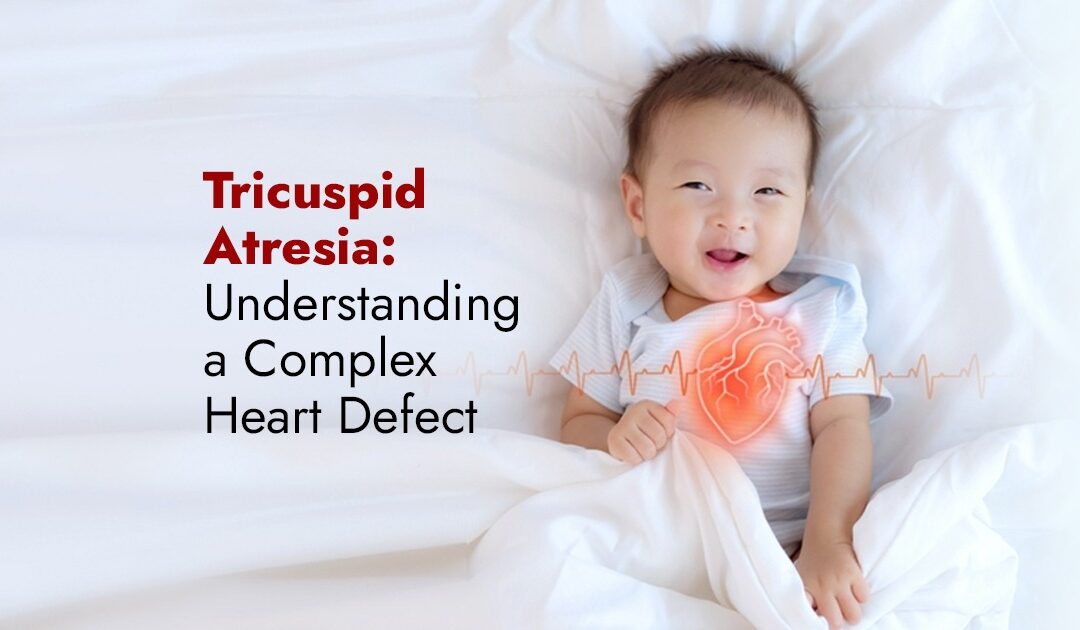Tricuspid atresia is a congenital heart defect (a birth condition) that arises when the heart’s tricuspid valve fails to form. The tricuspid valve is generally located between the right atrium (upper chamber) and the right ventricle (lower chamber) of the heart.
In tricuspid atresia, the tricuspid valve is replaced by solid tissue. This tissue sheet prevents blood flow from the right atrium to the right ventricle, where blood ordinarily flows. Because of this obstruction, the right ventricle is frequently tiny and undeveloped. The opposite valve on the right side, which connects the right ventricle to the lungs, might also be underdeveloped.
What are the different types of Tricuspid Atresia?
Healthcare practitioners classify tricuspid atresia cases into various groups. These are:
- Type I: Your baby’s pulmonary artery and aorta are in the proper location. They could, however, have a hole in the ventricle wall (ventricular septal defect) or a problem with their pulmonary valve.
- Type II: Your baby’s pulmonary artery and aorta are in the same location. There is also a ventricular septal defect and maybe an issue with your baby’s pulmonary valve.
- Type III (the rarest): Your baby’s pulmonary artery and aorta, as well as the right and left ventricles, are all misaligned.
What are the symptoms of tricuspid atresia?
Most babies with tricuspid atresia experience symptoms within a week after birth. A baby with tricuspid atresia may exhibit the following symptoms:
What are the tricuspid atresia symptoms?
In most cases, babies with tricuspid atresia have symptoms within a week of birth. A baby with tricuspid atresia can show the following symptoms:
- Skin and lips that are bluish in color (cyanosis).
- Trouble with feeding.
- Shortness of breath and rapid breathing.
- Slow growth.
- Heart murmur, i.e., unusual heart sounds).
- In addition, some babies with this condition can develop heart failure symptoms, as well.
Congenital heart disorders begin while a fetus is still in the uterus while the heart is developing. Someone with tricuspid atresia does not have enough blood going through their heart and into their lungs, where it receives oxygen. As a result, their lungs are unable to give sufficient oxygen to the rest of their body.
Tricuspid atresia is one of the most severe cardiac anomalies, according to healthcare specialists. This form of heart illness is often treated in an intensive care unit with expertise in complex congenital heart disease at birth. Although there are known risk factors for tricuspid atresia, the specific causes remain unknown.
How do you treat tricuspid atresia?
Medication given to babies born with tricuspid valve atresia can help maintain their patent ductus arteriosus open. This additional blood vessel, which typically closes after birth, allows blood to travel from the aorta to the pulmonary artery. This provides an alternative method of delivering blood to your baby’s lungs for oxygenation. Without a tricuspid valve, the traditional approach is ineffective.
Medicines can also benefit your baby’s heart muscle, making it stronger, and making the cells eliminate excess fluid. This disease is usually treated surgically shortly after a baby is born. Later on, your baby will undergo more surgery.
Tricuspid atresia is a complex and life-threatening congenital cardiac condition that necessitates specialized treatment from birth. The lack of the tricuspid valve significantly reduces the heart’s ability to pump oxygen-rich blood to the body, resulting in a series of problems. While the exact causes are unknown, early detection and treatment are critical for survival and enhanced quality of life. Medication and surgical procedures are the mainstays of treatment, with the goal of developing new blood flow channels and improving heart function. Seeking professional help is critical for parents who are navigating this difficult journey. For parents who are navigating this difficult road, getting competent help is critical.
Dr Jagadesh is the best heart surgeon and specialist in Hyderabad whose exceptional expertise in managing complex congenital heart conditions like tricuspid atresia provides hope and healing to countless families affected by this devastating disorder.

